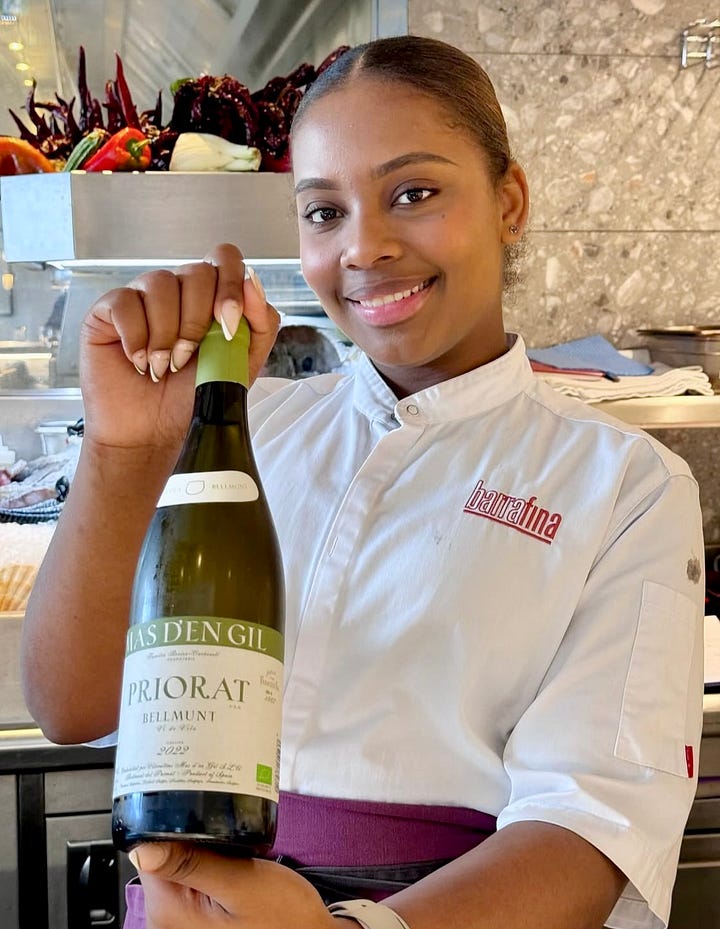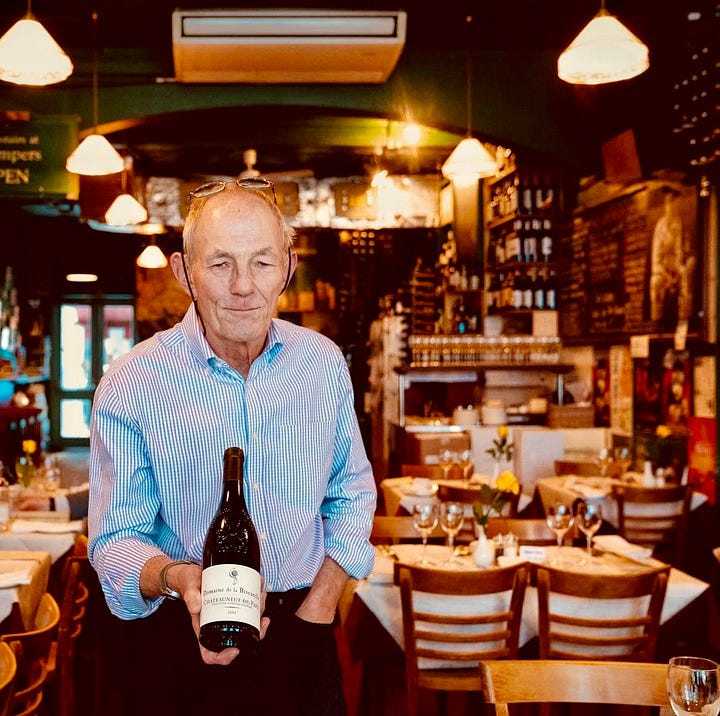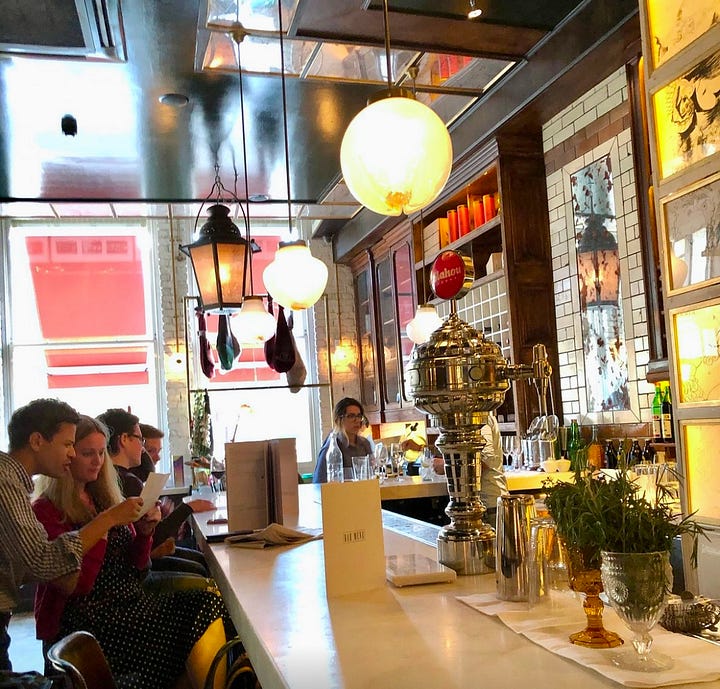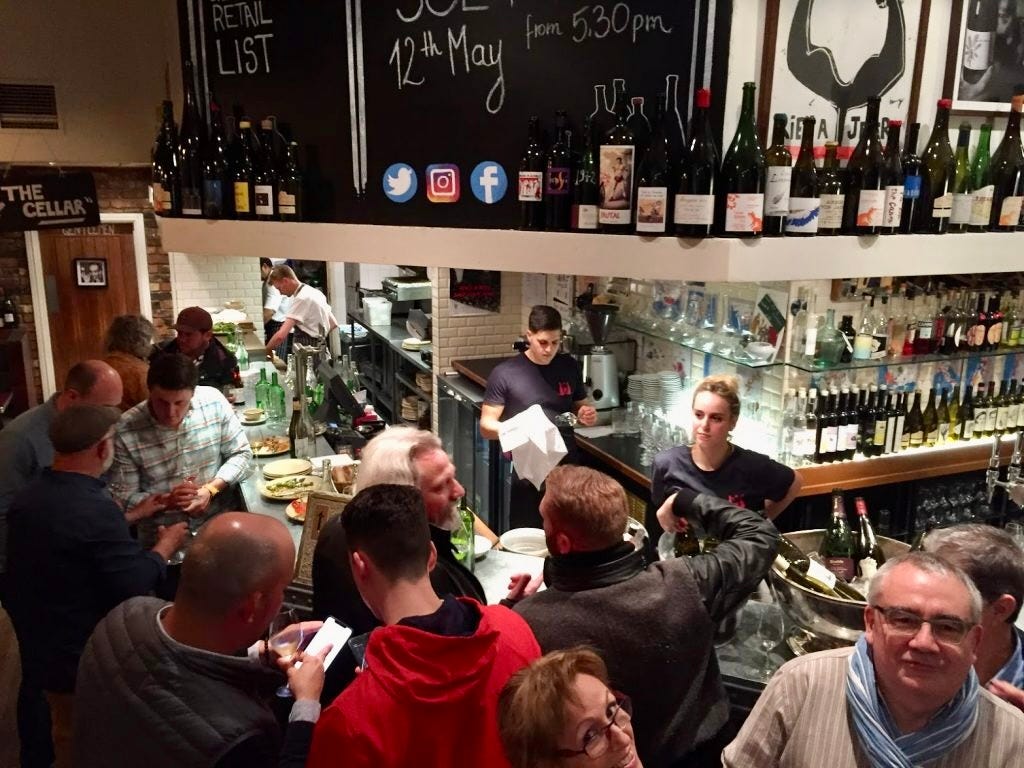The restaurants that draw us back
London's eateries face tough times. The best are those whose welcome makes us come back for more. Plus: what I've been drinking this week at the Paris wine fair




For all the ceaseless energy of London’s eating scene – the openings, the new concepts, starry chefs’ latest moves – what I crave are the dependable restaurants that you go back to. Maybe it’s partly my age, but I want food, ambience and service I can rely on, ease back into. Which made it additionally sad when one of my long-time go-to places, Ibérica, folded in December. My favourite branch, Farringdon, and one other will be taken over by the Camino chain.
I’ll say now that the Ibérica’s CEO, Marcos Fernández, is a friend, and I know the grief the collapse has caused him, after 17 years working to make the little chain a success. But while it’s always hard to separate out individual ventures’ woes from the wider business climate – and Ibérica had been sliding for a while – right now, London’s restaurant industry feels in a precarious state.
It's not just other places folding, like Fitrovia’s reliable Cin Cin, which closed in October, or Peckham’s Café Britaly, which shut in January after just eight months, despite critical acclaim (eg from, er, me). Last month, official figures showed that accommodation and food service business insolvencies jumped by almost a third from October to November of last year alone.
Some places seem to be managing fine: for example Kricket, another of my go-tos, is expanding to Shoreditch next month. But looming financial challenges make this a good point to consider what makes Londoners grant a restaurant the ultimate accolade: going back to them. For as one food PR friend says, “I feel like I've been to so many places that have received 'rave reviews' and it's been fine, decent food, but the standard to make me want to return when there's so much competition is quite high.” It would be a mistake to lose sight of that simple goal among the excitement of new openings.
The industry’s woes have been a while brewing. Many cite the lingering effect of the Covid lockdowns: the persistence of remote working has transformed central London’s footfall. Transport for London figures confirm that the busiest days on public transport are now at the weekend, with the quietest days Mondays and Fridays. The TWATs, as some disgruntled restaurateurs refer to them – people who come into the office on Tuesdays, Wednesday and Thursdays – have changed their going-out habits and thereby altered many restaurants’ rhythms.
This is just one of the problems facing London’s night-time industries. Last week Mayor Sir Sadiq Khan launched his Nightlife Taskforce, a group of industry insiders charged with coming up with solutions. It’s hard to see it amounting to more than a talking shop. Plenty of the issues are out of the Mayor’s control, such as alcohol licensing, run by the boroughs: earlier this month The Londoner showed the capital’s pubs are closing at a shocking rate as a result of noise complaints from residents.
But by far the biggest challenge for restaurants is cost, with galloping inflation in materials, wages, rents and energy. Recent annual increases just in the National Living Wage (the legal minimum for those aged over 21) of up to ten per cent will have added up to a cumulative increase, 2022-25, of 37 per cent. Nevertheless, Fernández tells me, “labour competition has been reduced to nothing. Staffing is a problem everywhere in Europe at present but it’s three times worse here.” He believes that “It’s all ultimately down to Brexit. Today there aren’t people out there that want to make a living in hospitality, like there were when we started [2008].”
So restaurants have jacked up prices – repeatedly. New figures out last month from credit ratings group Morningstar DBRS suggested that the UK has seen some of the biggest menu price hikes in the world. Restaurant.org says the stats show that “average prices at major national restaurant chains in the UK increased by an average of 20 per cent between the third quarter of 2023 and the summer of 2024.”
The contrast with many places in Europe, especially Spain, is striking – even though the latter has long since stopped being a cheap destination. On a recent visit to one well-known London tapas joint, my Spanish friend grimaced at the bill, over £100 for a bottle of wine and a few shared plates between two: “that’s taking the piss – think what you’d pay in Madrid!”
“Main courses are now regularly hitting £30-40,” points out food and drink writer Fiona Beckett. “Restaurants are getting progressively more expensive, which means that people will just go less often or get takeaway.” Or when people do go out, they spend less: Fernández says that over the past few years Ibérica saw spend per head fall 10 per cent year-on-year.
And all of this is before the effect of triple whammy for the restaurant industry announced by Chancellor Rachel Reeves in last October’s Budget. From 1 April, employers’ National Insurance contributions, will rise from 13.8 to 15 per cent, while the wage threshold at which they start paying them will drop from £9,100 to £5,000. In addition, the National Living Wage will go up another 6.7 per cent, to £12.21/hour. And on the same day, the business rates discount for retail, hospitality and leisure firms will drop from 75 to 40 per cent, capped at £110,000. The rates are seen by many as being out of touch with reality, based as they are on a premises’ rental value.
Industry body UK Hospitality estimates that its members will need to raise prices by an additional eight per cent this year just to cover the National Insurance increase. In addition, as of this month, there are the Government’s crazy changes to alcohol duty, a mad piece of Conservative red tape that will increase the price of most wine, including in restaurants.
All of which raises the stakes for restaurants trying to get us to return, to gain a place in our hearts as a go-to table. As Beckett says, it’s about “familiarity and warmth rather than a great gastronomic experience – though the food needs to be good.” But I think their food needs to be comforting, even if not necessarily hearty: there are times when I fancy a ceviche but not generally when settling down at the table with an old friend and a bottle. “I think there’s a continued shift towards elevated comfort food that took hold around the pandemic,” says food writer and former Evening Standard restaurant critic, Jimi Famurewa.
Part of the secret, he adds, is “places that are multi speed, where you can have a blow-out or just spend £15-20 at a solo lunch”. He points to the late Russell Norman’s Brutto – one of my favourites – and recalls Norman’s vision of a place with someone at one table having a big lunch of Florentine steaks, fancy wines and multiple Negronis, and up at the counter someone who works nearby just getting a plate of pasta and a glass of wine and not breaching the £20 mark. Says Famurewa: “Those restaurants we go back to insert themselves into different parts of our lives like that.”
You don’t necessarily need to know the owner or wait staff at your go-to joints, though it’s nice when you do. I still mourn the passing of Kingly St’s Shampers: we had part of our wedding reception there and when our first daughter was born, owner Simon Pearson gave us a bottle of pink champagne. I still miss his steak sandwiches. And while I didn’t know the owners of Terroirs – it closed in 2021 – I felt I almost did via its connection to natural wine importers Les Caves de Pyrene. So many boozy lunches… (now I think if it, they refused me service the last time I made a late-night stop at the bar.)
Memories of other places are tied up with stages of life and work. I’m sad the Belgravia branch of Lebanese Noura closed a while back (others remain open): I lunched politicians and laughed with friends and family at its starched white tablecloths. Rowley Leigh’s groundbreaking Kensington Place (closed 2019) was for a while almost a staff canteen for some Evening Standard execs, in a distant era of easy business expenses. Wódka, my other Kensington favourite, always felt like a place to contemplate one’s good fortune; it closed in the early 2010s.
Fortunately, they’ve been replaced at this point in my life by other joints. Any food and wine lover exploring this city’s neighbourhoods will find restaurants that they just somehow click with, even when they’re unshowy – maybe especially then. That range of restaurants is one of London’s joys – and one of its claims to remain a global city. In this tough spring for them, we should cherish the ones that draw us back.
Some of my current go-to London restaurants:
Franzina Trattoria – I’ve had an affection for Franzina since it first opened in a shipping container in Pop Brixton, and I’ve known chef and owner Pietro Franz since then. Good, affordable Sicilian food served in a slightly chaotic but friendly space on Coldharbour Lane.
Barrafina – one of the first of the new wave of London tapas joints (2008) and still one of the best, spanking-fresh Spanish food and good wine. All the branches are equally consistent, somehow.
Moro – Sam and Sam Hart’s Spanish-Moroccan fusion place just keeps chugging along after nearly 30 years now (since 1997), the ambience as relaxed as ever and the menu still one where I want to eat everything. Next door’s Morito offshoot is great for a cheaper alternative.
Kartuli – a slice of Tbilisi in a charming old grocery store in East Dulwich: the food is authentic, the Georgian wine selection excellent and the welcome warm. Always a relaxed pleasure.
Evi’s – OK, so a second East Dulwich resto here reflects in part the fact that this is my home turf, more or less. But I still wish this affordable, friendly Greek resto and its well-judged food were on my actual home turf, next door in Herne Hill.
What I’ve been drinking this week… at the Paris wine fair
For the past couple of days I’ve been immersed in one of the global wine industry’s biggest jamborees, Vinexpo, aka the Paris wine fair. With more than 4,000 exhibitors and over 41,000 visitors - and an aggressively international focus this year - it’s frankly a bit overwhelming. But there have, of course, been a lot of interesting wines to try, both at the fair and outside. These are some of my favourites this week:
Famille Gras “Les Grands Calcaires” 2022, Côtes du Rhône - a Grenache Blanc-led blend, this is well above average for a white Côtes du Rhône: fresh, mineral, quite precise. I drank this with dinner at charming bistro Astier, up near République (N/N UK.)
Lyrarakis Plakoura 2021, Crete - Lyrarakis are one of Crete’s most interesting producers, making wine from a range of sometimes obscure local grapes. This wine is from Mandilari, one of the biggest Cretan red varieties, grown up at 500 metres’ altitude: fragrant, spicy, elegant and quite long (the 2021 is N/A UK but the 2020 is available from Direct Wine Shipments, £21.99.)
Arzuaga Reserva Especial 2016, Ribera del Duero - at dinner on Sunday I found myself on the neighbouring table at Auberge Bressane to the guys from Arzuaga, a fine Ribera del Duero producer, and they shared this beautiful, deep, plush red they had brought with them (the 2016 is N/A UK; the 2019, which is good but needs longer, is available in the UK from Grapey, Spanish Wines Direct, from £46.)





I speak to restaurant owners and they don’t know how they’re going to get through the year. Even with higher sales prices they’re just breaking even, or running at a loss.
That "100£ for a bottle of wine and a few shared plates" will be less in Barcelona and Madrid but not that much less.
Meals for two in decent places with no wine are running about 70-80€ these days. Even the 'menú del dia' spots are 20-25€ a person and I'm usually still hungry.
This "Spain is so cheap" I hear from British colleagues when in Spain only applies to a few spots now. Wine is definitely cheaper though as it's produced here with far lower taxes. But keep in mind that Spanish salaries are about 1/2 to 1/3 of those in the UK so this is even more expensive than it seems if one is local.